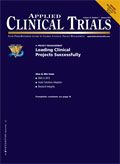Will CROs Drive Faster Solutions Adoption?
Applied Clinical Trials
As integrated alliances assume more risk, novel strategies and practice must follow.
Outsourcing has played an important role in drug development for more than 30 years. But arguably, that role has been largely reactive to sponsor needs and direction. New outsourcing relationships are a potential game-changer: leading CROs are now positioned to play an unprecedented new role in proactively and aggressively transforming clinical research.

Kenneth A. Getz
Here's how: strategic and integrated partnerships are facilitating the rapid transfer of operating and resource risk from pharmaceutical companies to CROs. To successfully manage these highly valued relationships, leading contract service providers are taking on substantially more fixed costs, assuming more autonomy and accountability, and investing in the adoption of innovative practices and solutions at levels that far surpass those typically made by their counterpart, risk-averse sponsor companies.
Handing-off risk
Nearly all large sponsor companies—major and many mid-sized pharmaceutical and biotechnology companies—have actively embraced the use of integrated relationships where entire functions or portions of a portfolio are managed more autonomously by select preferred providers under long-term alliance arrangements. Sponsors hope to not only access dedicated global capacity, talent, and experience more efficiently, but also to secure cost savings through reduced start-up and guaranteed portfolio activity.
The largest CROs are uniquely positioned to provide the breadth and depth of capacity that sponsor portfolios require. These CROs have been the primary beneficiaries of integrated and strategic partnerships. A recent study conducted by CenterWatch found that for leading CRO companies, the majority of their revenue comes from strategic, integrated relationships. Among the top 10 largest CROs, 71% of their reported revenue comes from functional service and integrated alliances, and 29% from transactional relationships. In contrast, the majority (60%) of revenue for niche and mid-size CROs comes from transactional service relationships. Smaller pharmaceutical and biotechnology companies continue to primarily use transactional relationship outsourcing —often under preferred arrangements—to augment capacity for a specific project-related task.
Greater autonomy in managing large and highly valued integrated partnerships is but one aspect of operating and resource risk transferred to CROs. Customization is also driving up risk since no two partnerships are identical. One sponsor's integrated alliance is not the same as another. Every sponsor wants to establish relationships that uniquely suit their culture, operating style, strategy, systems, practices, and management models. Each and every sponsor wants to match its internal teams with the best team that the contract service partner can offer. Customization cannot be scaled. It demands greater CRO infrastructure and management, erodes the CRO's ability to operate efficiently, and squeezes CRO company profitability.
Uniquely motivated to deliver
An overwhelming majority of CRO professionals (80%) expect sponsor-use of integrated alliances to continue to significantly increase during the next three-to-five years according to that same CenterWatch study noted earlier. The capital markets affirm this optimism. GBI Research, for example, forecasts a 12% to 15% annual growth rate in the contract clinical services market through 2020.
Market leading CROs covet their integrated, strategic relationships. These relationships have high revenue potential and offer continuity and access to the largest and most active pharmaceutical and biotechnology companies. Next-tier CROs have also looked to get in on the game by scaling capacity and capabilities through mergers and acquisitions.
Given the size and scope of each integrated alliance, CROs are hard-pressed to lose them. The termination of a single alliance will be highly disruptive to a major CRO's financial and operating stability. Major CROs are highly motivated to ensure that they deliver on the promise of efficiency and cost savings.
Sponsors are eager—many might say impatient—for results. Sponsor companies are looking for measurable improvement despite the fact that the majority of these relationships have only had a few years to take hold and that sponsors have had limited experience designing, executing, and supporting integrated relationships.
Two reports this past year suggest that integrated relationships are delivering mixed results. Based on interviews with top 20 pharmaceutical companies, Booz & Company found that integrated relationships have been entered into actively without sponsor companies carefully thinking through the necessary support mechanisms and without aligning outsourcing and corporate strategies.
Another report in 2012 from The Avoca Group found that one out of five (22%) sponsors had discontinued a strategic alliance largely due to poor performance and quality. Specifically, the survey found that: 16% of sponsors said that their partnerships failed to meet their cost saving expectations, and another 36% delivered mixed cost saving results; 21% of sponsors said that their alliances had failed to reduce the level of internal resources dedicated to oversight and coordination, and another third reported mixed results; and 17% of sponsors said that their alliances had failed to generate operating efficiencies, and another 40% said that operating efficiencies were only being met part of the time.
In 2013, most large sponsor companies will likely modify their integrated relationships to address these shortcomings. Sponsors will adjust governance structures, collaborative processes, and practices. Many are already exploring ways to empower internal staff at the execution-level, to more actively manage communication and coordination processes and systems, and to more effectively measure collaborative performance.
Regardless of where real blame lies for the mixed or poor performance of integrated partnerships, invariably it is the CRO in that relationship who must bear the burden of failure.
Facing risk resourcefully
Unique motivational factors combined with the current operating environment for integrated relationships are pushing leading CROs to innovate at levels never seen before. Top CROs have been very active during the past 18 months in executing initiatives to mitigate operating and resource risk. Many are consolidating assets, subcontracting non-core capabilities that are a drain on their profitability, and turning to the private equity markets to adjust their business mix and correct their performance away from public market scrutiny.
Leading CROs are aggressively pursuing new and innovative initiatives to facilitate sustainably higher levels of speed and efficiency. They have introduced a number of eClinical solutions designed to simplify and optimize data and project management and to coordinate disparate technologies. Perceptive Informatic's (Parexel) launch of the MyTRIALS platform and Icon's launch of ICONIK are two such examples.
Investigative site performance and patient recruitment and retention are areas receiving considerable attention lately. The study conduct arena is arguably one of the most highly inefficient and unpredictable. It is also an area to which the success of integrated partnerships is most measured. The number and quality of investigative sites engaged; the proportion of sites achieving enrollment targets; the rate and number of patients enrolled, discontinued and evaluable—are but a few key success factors to which CROs handling these functions under alliance arrangements are held accountable.
Various investigative site performance optimization solutions have been launched recently including Covance's Xcellerate methodology and Icon's Firecrest Clinical. Quintiles has been highly active building up its global Partner Sites and Prime Sites programs to establish more structured and supported relationships with 1,000 research centers and 16 major hospitals respectively. Other major CROs have also been actively establishing relationships with investigative sites around the world with the primary goals of improving control over site performance and success.
The ties between pharmaceutical and biotechnology companies and the research professional and patient communities are highly regulated and must be kept at sufficient distance. CROs have far greater latitude to establish closer relationships with these stakeholders. To name but a few notable initiatives designed to improve patient recruitment success and gain access to patient data: Quintiles' 2012 launch of its Digital Patient Unit marks the culmination of the company's efforts to establish online interactive patient communities that bridge healthcare and clinical research. PPD launched PatientView in 2011, connecting patients with research and healthcare professionals and enabling study volunteers to more actively manage their medical information.
The list of innovative solutions implemented by CROs during the past 20 months are impressive and greatly exceed the space allowed here. The key takeaway is that top CROs are uniquely motivated in the current operating environment to pursue novel approaches—that leverage manpower, rich performance data, and online communities —to help streamline and optimize development performance.
Sufficient time and support
The intense pressure to achieve higher levels of clinical development speed and efficiency at lower cost has never been greater. Dynamics of the current outsourcing environment, specifically the shift toward strategic integrated alliances and the transfer of operating and resource risk, are pushing CROs out of their comfort zone and beyond the confines of their clients' operating philosophies and practices to create and implement solutions far more innovative than have been traditionally generated, and to weigh aggressive growth strategies that may redefine the scope of contract services traditionally offered. Hopefully these novel strategies and approaches will be given sufficient time and support by sponsors and CROs alike to demonstrate their impact on transforming drug development practice.
Kenneth A. Getz MBA, is a Senior Research Fellow at the Tufts CSDD and Chairman of CISCRP, both in Boston, MA, email: kenneth.getz@tufts.edu

Improving Relationships and Diversifying the Site Selection Process
April 17th 2025In this episode of the Applied Clinical Trials Podcast, Liz Beatty, co-founder and chief strategy officer, Inato, discusses a number of topics around site engagement including community-based sites, the role of technology in improving site/sponsor relationships, how increased operational costs are impacting the industry, and more.
Behind the Buzz: Why Clinical Research Leaders Flock to SCOPE Summit
February 7th 2025In this episode, we meet with Micah Lieberman, Executive Conference Director for SCOPE Summit (Summit for Clinical Ops Executives) at Cambridge Innovation Institute. We will dive deep into the critical role of collaboration within the clinical research ecosystem. How do we bring together diverse stakeholders—sponsors, CROs, clinical trial tech innovators, suppliers, patients, sites, advocacy organizations, investors, and non-profits—to share best practices in trial design, program planning, innovation, and clinical operations? We’ll explore why it’s vital for thought leaders to step beyond their own organizations and learn from others, exchanging ideas that drive advancements in clinical research. Additionally, we’ll discuss the pivotal role of scientific conferences like SCOPE Summit in fostering these essential connections and collaborations, helping shape the future of clinical trials. Join us as we uncover how collective wisdom and cross-industry partnerships are transforming the landscape of clinical research.
FDA-Approved Gene Therapy Beqvez Shows Sustained Efficacy, Safety in Long-Term Hemophilia B Trial
April 17th 2025Beqvez (fidanacogene elaparvovec), an FDA-approved one-time gene therapy for hemophilia B, demonstrated sustained factor IX expression, low bleeding rates, and a favorable safety profile over long-term follow-up.